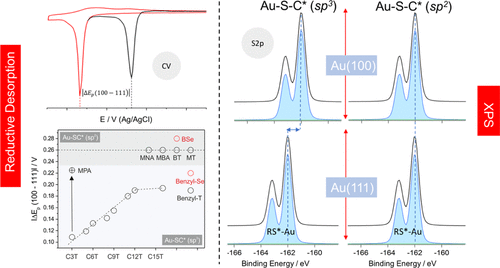Our official English website, www.x-mol.net, welcomes your
feedback! (Note: you will need to create a separate account there.)
Comparative Study of the Adsorption of Thiols and Selenols on Au(111) and Au(100)
Langmuir ( IF 3.7 ) Pub Date : 2017-11-14 00:00:00 , DOI: 10.1021/acs.langmuir.7b03038 Nicolás Arisnabarreta 1 , Gustavo D. Ruano 2 , Magalí Lingenfelder 3 , E. Martín Patrito 1 , Fernando P. Cometto 1, 3
Langmuir ( IF 3.7 ) Pub Date : 2017-11-14 00:00:00 , DOI: 10.1021/acs.langmuir.7b03038 Nicolás Arisnabarreta 1 , Gustavo D. Ruano 2 , Magalí Lingenfelder 3 , E. Martín Patrito 1 , Fernando P. Cometto 1, 3
Affiliation

|
The effect of the Au crystalline plane on the adsorption of different thiols and selenols is studied via reductive desorption (RD) and X-ray photoelectron spectroscopy (XPS) measurements. Self-assembled monolayers (SAMs) using aliphatic (ATs) and aromatic thiols (ArTs) on both Au(111) and Au(100) were prepared. The electrochemical stability of these SAMs on both surfaces is evaluated by comparing the position of the RD peaks. The longer the AT chain the more stable the SAM on Au(100) when compared to Au(111). By means of XPS measurements, we determine that the binding energy (BE) of the S 2p signal corresponding to the S atoms at the thiol/Au interface, commonly assigned at 162.0 eV, shifts 0.2 eV from Au(111) to Au(100) for SAMs prepared using thiols with the C* (C atom bonded to S) in sp3 hybridization, such as ATs. However, when the thiol presents the C* with an sp2 hybridization, such as in the case of ArTs, the BE remains at 162.0 eV regardless of the surface plane. Selenol-based SAMs were characterized comparatively on both Au(100) and Au(111). Our results show that selenol SAMs become even more electrochemically stable on Au(100) with respect to Au(111) than the analogue sulfur-based SAM. According to our results, we suggest that the electronic distribution around the Au–S/Se bond could be responsible for the different structural arrangements reported in the literature (gold adatoms, etc.), which should be dependent on the crystalline face (Au(hkl)–S) and the chemical nature of the environment of the adsorbates (sp3-C* vs sp2-C* and Au–SR vs Au–SeR).
中文翻译:

硫醇和硒醇在Au(111)和Au(100)上的吸附比较研究
通过还原解吸(RD)和X射线光电子能谱(XPS)测量研究了金晶面对不同硫醇和硒醇吸附的影响。制备了在Au(111)和Au(100)上使用脂肪族(AT)和芳香族硫醇(ArT)的自组装单分子膜(SAMs)。通过比较RD峰的位置来评估这些SAM在两个表面上的电化学稳定性。与Au(111)相比,AT链越长,SAM在Au(100)上的稳定性就越高。通过XPS测量,我们确定与硫醇/金界面上的S原子相对应的S 2p信号的结合能(BE)(通常分配为162.0 eV)从Au(111)转移到Au(100)100 e )用于在sp 3中使用具有C *(C原子与S键合)的硫醇制备的SAM杂交,例如AT。但是,当巯基以sp 2杂交方式与C *结合时(例如在ArTs中),无论表面如何,BE都保持在162.0 eV。基于硒醇的SAMs在Au(100)和Au(111)上均进行了比较表征。我们的结果表明,相对于Au(111),硒醇SAMs在Au(100)上的电化学稳定性甚至高于类似的基于硫的SAM。根据我们的结果,我们建议Au-S / Se键周围的电子分布可能是导致文献报道的不同结构排列的原因(金原子原子等),这应取决于晶面(Au(hkl)–S)和被吸附物环境的化学性质(sp 3 -C * vs sp2 -C *和Au–SR与Au–SeR)。
更新日期:2017-11-15
中文翻译:

硫醇和硒醇在Au(111)和Au(100)上的吸附比较研究
通过还原解吸(RD)和X射线光电子能谱(XPS)测量研究了金晶面对不同硫醇和硒醇吸附的影响。制备了在Au(111)和Au(100)上使用脂肪族(AT)和芳香族硫醇(ArT)的自组装单分子膜(SAMs)。通过比较RD峰的位置来评估这些SAM在两个表面上的电化学稳定性。与Au(111)相比,AT链越长,SAM在Au(100)上的稳定性就越高。通过XPS测量,我们确定与硫醇/金界面上的S原子相对应的S 2p信号的结合能(BE)(通常分配为162.0 eV)从Au(111)转移到Au(100)100 e )用于在sp 3中使用具有C *(C原子与S键合)的硫醇制备的SAM杂交,例如AT。但是,当巯基以sp 2杂交方式与C *结合时(例如在ArTs中),无论表面如何,BE都保持在162.0 eV。基于硒醇的SAMs在Au(100)和Au(111)上均进行了比较表征。我们的结果表明,相对于Au(111),硒醇SAMs在Au(100)上的电化学稳定性甚至高于类似的基于硫的SAM。根据我们的结果,我们建议Au-S / Se键周围的电子分布可能是导致文献报道的不同结构排列的原因(金原子原子等),这应取决于晶面(Au(hkl)–S)和被吸附物环境的化学性质(sp 3 -C * vs sp2 -C *和Au–SR与Au–SeR)。











































 京公网安备 11010802027423号
京公网安备 11010802027423号